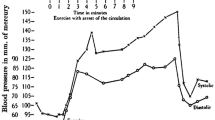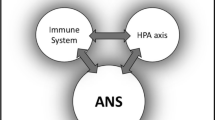Summary
1. In the presence of atropine and guanethidine (3 μmol/l each), electrical field stimulation (1–20 Hz) produced frequency-dependent relaxations of the histamine-(3 μmol/l) induced vascular tone in isolated rings from the guinea-pig pulmonary artery. The electrically-evoked relaxations were abolished by tetrodotoxin (1 μmol/l). The amplitude of these nerve-mediated, nonadrenergic non-cholinergic (NANC) relaxations was unaffected by removal of the vascular endothelium produced through rubbing of the internal surface. 2. Capsaicin (1 μmol/l) produced a prompt and sustained relaxation of the histamine-induced tone which was unaffected by removal of the endothelium. A second application of capsaicin 60–120 min later had no further relaxant effect, indicating desensitization. After in vitro capsaicin desensitization, the electrically-evoked NANC relaxations were abolished, both in the presence or absence of the vascular endothelium. 3. Substance P evoked a prompt and transient relaxation in precontracted arterial rings with intact endothelium and a transient small contraction in rings in which the endothelium had been mechanically removed. The selective NK-1 receptor agonist, [Pro9]-substance P sulfone closely mimicked the relaxation produced by substance P while the selective NK-2 or NK-3 receptor agonists had no relaxant effect. Tachyphylaxis to substance P did not modify the amplitude of the capsaicin-induced relaxation. 4. Human alpha calcitonin gene-related peptide (CGRP) produced a prompt and sustained relaxation both in the presence and absence of the vascular endothelium. 5. Ruthenium red (10 μmol/l) blocked the relaxation to capsaicin while leaving unaffected the relaxation to electrical field stimulation or CGRP (0.1 μmol/l). 6. Both substance P (SP)-and CGRP-like immunoreactivities (LI) were detected in extracts of the guinea-pig pulmonary artery. Capsaicin (1 μmol/l) evoked a prompt and simultaneous outflow of both SP- and CGRP-LI. A second application of capsaicin 60 min later failed to increase SP- or CGRP-LI outflow, indicating complete desensitization. A small but clearly detectable release of both SP-LI and CGRP-LI was also evoked by electrical field stimulation. 7. These findings provide evidence that the neurogenic NANC vasodilation in the guinea-pig pulmonary artery is due to antidromic activation of peripheral endings of capsaicin-sensitive primary afferents. Endogenous CGRP is a likely mediator for this vasodilation. No evidence was found that endogenous SP might contribute to vasodilation by activating NK-1 receptors on endothelial cells.
Similar content being viewed by others
References
Amann R, Lembeck F (1989) Ruthenium red selectively prevents capsaicin-induced nociceptor stimulation. Eur J Pharmacol 161:227–229
Amann R, Donnerer F, Lembeck F (1989) Ruthenium red selectively inhibits capsaicin release of calcitonin gene-related peptide from the isolated perfused guinea-pig lung. Neurosci Lett 101:311–315
Bao JX, Stjarne L (1989) Field stimulation-induced, endothelium-dependent relaxation of rat tail artery is blocked by alpha, beta methylene ATP and known inhibitors of the arachidonic acid cascade. Acta Physiol Scand 137:153–154
Barthó L, Pethó G, Antal A, Holzer P, Szolcsanyi J (1987) Two types of relaxation due to capsaicin in the guinea-pig isolated ileum. Neurosci Lett 81:146–150
Beny JL, Brunet PC, Huggel H (1989) Effects of substance P, CGRP and capsaicin on tension and membrane potential of pig coronary artery in vitro. Regul Pept 25:25–36
Brain SD, Williams TJ, Tippins JR, Morris HR, Mac Intyre I (1985) Calcitonin gene-related peptide is a potent vasodilator. Nature 313:54–56
Chahl L (1989) The effects of Ruthenium red on the response of guinea-pig ileum to capsaicin. Eur J Pharmacol 169:241–247
Coleridge HM, Coleridge JCG (1980) Cardiovascular afferents involved in regulation of peripheral vessels. Annu Rev Physiol 42:413–427
D'Orleans-Juste P, Dion S, Mizrahi J, Regoli D (1985) Effects of peptides and non-peptides on isolated arterial smooth muscles: role of endothelium. Eur J Pharmacol 114:9–21
D'Orleans-Juste P, Dion S, Regoli D (1986) Different receptors are involved in the endothelium-dependent relaxation and the smooth muscle contraction of the rabbit pulmonary artery in response to substance P and related neurokinins. Eur J Pharmacol 125:37–45
Duckles SP (1986) Effects of capsaicin on vascular smooth muscle. Naunyn-Schmiedeberg's Arch Pharmacol 333:59–64
Edvinsson L, Fredholm B, Hamel E, Jansen I, Verrecchia C (1985) Perivascular peptides relax cerebral arteries with stimulation of cyclic adenosine monophosphate accumulation or release of an endothelium-dependent relaxing factor in the cat. Neurosci Lett 58:213–217
Franco-Cereceda A, Rudehill A (1989) Capsaicin-induced vasodilatation of human coronary arteries in vitro is mediated by CGRP rather than substance P or neurokinin A. Acta Physiol Scand 136:575–580
Franco-Cereceda A, Rudehill A, Lundberg JM (1987) CGRP but not substance P mimics capsaicin-induced coronary vasodilatation in the pig. Eur J Pharmacol 142:235–243
Frank GW, Bevan JA (1983) Electrical stimulation induces endothelium dependent relaxation in lung vessels. Am J Physiol 244:H793-H798
Furness JB, Papkia RE, Della NG, Costa M, Eskay RL (1982) Substance P-like immunoreactivity in nerves associated with the vascular system of guinea-pigs. Neuroscience 7:447–459
Grace GC, Dusting GJ, Kemp BE, Martin TJ (1987) Endothelium and the vasodilator action of rat CGRP. Br J Pharmacol 91:729–733
Greenberg B, Rhoden K, Barnes P (1987) CGRP is a potent nonendothelium-dependent inhibitor of coronary vasomotor tone. Br J Pharmacol 92:789–794
Gulbenkian S, Merighi A, Wharton J, Varndell IM, Polak JM (1986) Ultrastructural evidence for the co-existence of CGRP and SP in secretory vesicles in the peripheral nervous system of guineapig. J Neurocytol 15:535–542
Holzer P (1988) Local effector functions of capsaicin-sensitive sensory nerve endings: involvement of tachykinins, Calcitonin generelated peptide and other neuropeptides. Neuroscience 24: 739–768
Kawasaki H, Takasaki K, Saito A, Goto K (1988) CGRP acts as a novel vasodilator transmitter in mesenteric resistance vessels of the rat. Nature 335:164–167
Kotecha N, Neild TO (1986) Effects of the endothelium-derived relaxing factor on the smooth muscle of the rat tail artery. Clin Exp Pharmacol Physiol 13:249–257
Kubota E, Hamasaki Y, Sata T, Saga T, Said SI (1988) Autonomic innervation of pulmonary artery: evidence for a nonadrenergic noncholinergic inhibitory system. Exp Lung Res 14:349–358
Loesch A, Burnstock G (1988) Ultrastructural localization of serotonin and substance P in vascular endothelial cells of rat femoral and mesenteric arteries. Anat Embryol (Berl) 178:137–142
Maggi CA, Meli A (1988) The sensory-effect function of capsaicinsensitive primary sensory neurons. Gen Pharmacol 19:1–43
Maggi CA, Santicioli P, Meli A (1987) Four motor effects of capsaicin on guinea-pig distal colon. Br J Pharmacol 90:651–660
Maggi CA, Santicioli P, Geppetti P, Parlani M, Astolfi M, Pradelles P, Patacchini R, Meli A (1988) The antagonism induced by Ruthenium red of the actions of capsaicin on the peripheral terminals of sensory neurons: further studies. Eur J Pharmacol 154:1–10
Maggi CA, Patacchini R, Santicioli P, Giuliani S, Del Bianco E, Geppetti P, Meli A (1989) The “efferent” function of capsaicin-sensitive nerves: ruthenium red discriminates between different mechanisms of activation. Eur J Pharmacol 170:167–177
Manzini S, Perretti F (1988) Vascular effects of capsaicin in isolated perfused rat mesenteric bed. Eur J Pharmacol 148:153–159
Martling CR, Saria A, Fischer JA, Hokfelt T, Lundberg JM (1988) CGRP and the lung: neuronal co-existence with substance P, release by capsaicin and vasodilatory effect. Regul Pep 20:125–139
Martling CR, Matran R, Alving K, Lacroix JS, Lundberg JM (1989) Vagal vasodilatory mechanisms in the pig bronchial circulation preferentially involve sensory nerves. Neurosci Lett 96:306–311
Matran R, Alving K, Martling CR, Lacroix JS, Lundberg JM (1989) Vagally mediated vasodilatation by motor and sensory nerves in the tracheal and bronchial circulation of the pig. Acta Physiol Scand 135:29–37
McCulloch J, Uddmann R, Kingman RA, Edvinsson L (1986) CGRP: functional role in cerebrovascular regulation. Proc Natl Acad Sci USA 83:5731–5735
Minami Y, Onoue H, Toda N (1989) Extraluminally applied acetylcholine and substance P on the release of EDRF. Jpn J Pharmacol 50:362–365
Regoli D, Drapeau G, Dion S, Couture R (1988) New selective agonists for neurokinin receptors: pharmacological tools for receptor characterization. Trends Pharmacol Sci 9:290–295
Rovero P, Pestellini V, Rhaleb NE, Dion S, Rouissi C, Tousignant S, Telemaque S, Drapeau G, Regoli D (1989) Structure activity studies of neurokinin A. Neuropeptides 13:263–271
Saito A, Masaki T, Lee TJF, Goto K (1988) Effects of capsaicin on the contractility and peptide-containing nerves of large cerebral arteries of the cat. Arch Int Pharmacodyn Ther 295:194–203
Saito A, Masaki T, Uchiyama Y, Lee TJF, Goto K (1989) CGRP and vasodilator nerves in large cerebral arteries of cats. J Pharmacol Exp Ther 2A8:455–461
Szolcsanyi J (1984) Capsaicin-sensitive chemoceptive neural system with dual sensory-efferent function. In: Chahl L, Szolcsány J, Lembeck F (eds). Akademiai Kiado, Budapest, pp 26–52
Thom SMG, Hughes AD, Goldberg P, Martin G, Shchter M, Sever PS (1987) The actions of CGRP and vasoactive intestinal peptide as vasodilators in man in vivo and in vitro. Br J Clin Pharmacol 24:139–144
Uddman R, Edvinsson L, Ekblad E, Hakanson R, Sundler F (1986) CGRP: perivascular distribution and vasodilatory effects. Regul Pept 15:1–23
Wharton J, Gulbenkian S (1987) Peptides in the mammalian cardiovascular system. Experientia 43:821–832
Wharton J, Gulbenkian S, Mulderry PK, Ghatei MA, McGregor GP, Bloom SR, Polak JM (1986) Capsaicin induces a depletion of Calcitonin gene-related peptide (CGRP) immunoreactive nerves in the cardiovascular system of the guinea-pig and rat. J Anton Nerv Syst 16:289–309
Author information
Authors and Affiliations
Additional information
Send offprint requests to C. A. Maggi at the above address
Rights and permissions
About this article
Cite this article
Maggi, C.A., Patacchini, R., Perretti, F. et al. Sensory nerves, vascular endothelium and neurogenic relaxation of the guinea-pig isolated pulmonary artery. Naunyn-Schmiedeberg's Arch Pharmacol 342, 78–84 (1990). https://doi.org/10.1007/BF00178976
Received:
Accepted:
Issue Date:
DOI: https://doi.org/10.1007/BF00178976




